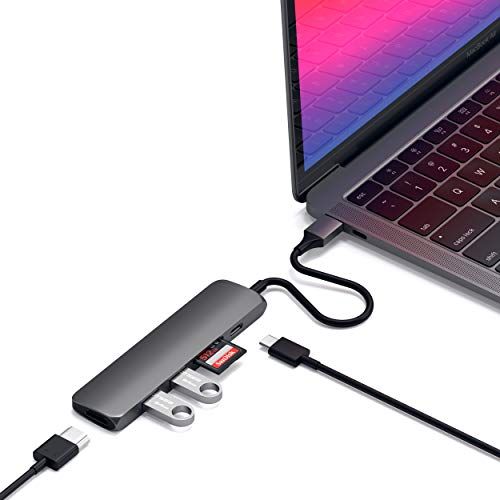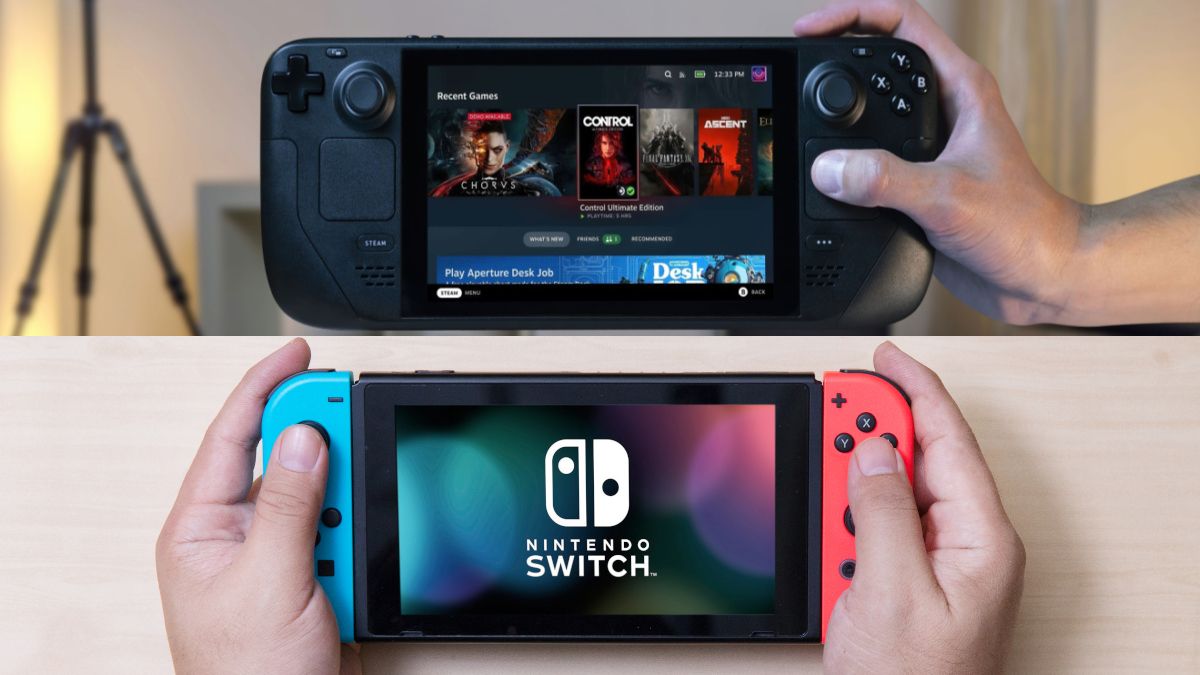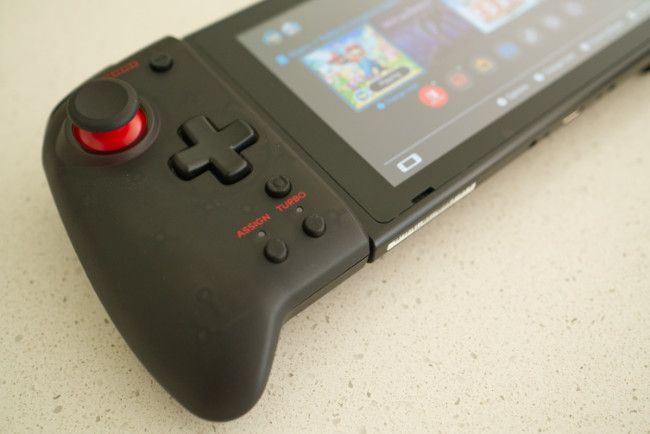Quick Links
Comparisons between the Valve Steam Deck and Nintendo Switch are hard to avoid---but not always helpful. They're very different devices with very different philosophies, and they're both great. Here's a rundown of what you need to know.
The Biggest Difference: Parts and Performance
The Nintendo Switch and Valve Steam Deck share a lot of similarities, but there are some big differences in terms of overall power and performance. The Switch was released in early 2017 and is powered by the NVIDIA Tegra X1 system-on-chip (SoC) running at 1.02GHz, with a total of 4GB LPDDR4 RAM.
Its NVIDIA Maxwell-based GPU runs between 307 and 768MHz, depending on whether you're playing in portable or docked mode. On-board storage takes the form of 32 or 64 GB of eMMC flash memory, which delivers roughly the same performance as the microSD expansion card slot (around 95MB/sec, which is why expensive microSD cards won't improve Switch performance).
In contrast, the Steam Deck saw release in early 2022, a full five years later than the Switch. It's powered by a custom AMD accelerated processing unit (APU) that's based on Zen 2 (CPU) and RDNA 2 (GPU) architectures, the same technology that helped build the Xbox Series X and PlayStation 5. The CPU runs between 2.4 and 3.5 GHz, and the system has access to 16GB of LPDDR5 RAM.
Valve has compared the GPU capabilities of the Steam Deck to that of the Radeon RX 6000 series, running between 1 and 1.6 GHz. The base Steam Deck uses similar eMMC flash memory as the Switch but employs the faster PCI Express 2.0 x1 standard (up to 500MB/sec). The mid and upper tiers use faster NVMe-based SSDs for improved read and write times.
The Steam Deck enjoys higher clock speeds, newer CPU and GPU architectures, a larger pool of RAM, and faster storage options than the Switch. You wouldn't be wrong on any level if you said that the Steam Deck is five years ahead of the Switch in terms of hardware. Though there's a lot more to analyzing the performance of both machines than a simplistic "bigger number = better performance" read, the difference between the two machines represents a generational leap in terms of handheld performance.
One area where Nintendo may have the advantage however is in the display on the Switch OLED model. Valve opted for a 1280x800 LCD, which uses LED backlighting, which can result in washed-out blacks and a less-than-stellar contrast ratio. By contrast, the OLED Switch sports a 1280x720 (720p) self-emissive panel that allows pixels to turn off completely for a more striking result.
What You'll Be Playing: The Games
The Switch plays games that were created specifically for Nintendo's system (and some older ones that have been optimized). This includes an arsenal of Nintendo first-party exclusives, including Mario Odyssey, Metroid Dread, and the highly acclaimed The Legend of Zelda: Breath of the Wild.
You're never going to officially see these games released on another system because that's not how Nintendo operates. Games can be enjoyed using physical cartridges or downloaded from a single store, the Nintendo eShop. Thanks to the success of the Switch there's an ever-expanding catalog of games to choose from, and a huge number of promotions happening at any one time.
By contrast, the Steam Deck uses a custom Linux distribution to play Steam releases that were mostly written with Windows in mind. This is possible thanks to a compatibility layer called Proton. Games are further optimized by developers and showcased in Valve's Deck Verified program. Some games work perfectly from the outset, some scrape by, while others deliver an inconsistent experience.
You can attempt to run just about any Steam game on your Steam Deck, many of which run just as well as they do on a PC. Because the Steam Deck runs a modified version of Arch Linux, you can install games from anywhere like you can on a regular PC. It's also possible to install different operating systems (like Windows) and make use of third-party stores if you can get them running.
This freedom extends to standard applications that would never make it onto a closed system like the Switch. Think emulators, torrent clients, benchmarking utilities, and so on. Since the Steam Deck targets Steam releases, you can also take advantage of Valve's epic winter and summer sales.
Having access to Steam provides much greater access to new high-end titles and emerging early access games, many of which flourish on Valve's platform. Smaller indie developers have been responsible for some of the biggest hits of the last few years, with titles like Valheim, Vampire Survivors, and Teardown shooting to success while console owners wait for a port to arrive.
In short, the Switch is a closed ecosystem that's full of Nintendo classics. While performance isn't always optimal, there's no guesswork involved in determining whether a title will run. By contrast, the Steam Deck is a system that comes with a lot more unknowns, but a lot more freedom to work things out. Software must be loaded digitally on a platform that rewards curiosity and tinkering, with less hand-holding along the way.
Two Different Philosophies: The Ecosystem
The difference in approach taken by Nintendo and Valve is a reflection of what each system represents. The Switch is a portable hybrid console, while the Steam Deck is a fully-fledged PC in a small package. The freedom afforded to Steam Deck users to install software, change the operating system, and even conduct self-repairs.
Valve made this evident in a video released a few months prior to the Steam Deck launch where they state that "you have every right to open it up and do what you want," but also "we at Valve really don't recommend that you ever open it up." Valve staff went on to warn that SSD upgrades could significantly shorten the lifespan of the unit due to heat output.
By comparison, your Nintendo Switch warranty is void the second you open the case. If you've suffered from dreaded Joy-Con drift you may be able to claim an extension on your warranty, but in some countries Nintendo may charge you for the privilege of a fix. Fortunately you can still make changes to the Switch experience with aftermarket accessories like the Fixture S1 controller clip and a portable dock.
Steam Deck online play has been slightly hampered by Proton interfering with anti-cheat technologies, but where online play exists it's a simple case of jumping in. On the Switch, online play requires a Nintendo Switch Online subscription (as is the case on competing Xbox and PlayStation platforms).
Voice chat has been moved to the Nintendo Switch Online app for iPhone and Android, which further complicates things. Fortunately, you get a few extras with a Nintendo Switch Online subscription like access to NES and SNES games, cloud save backups, and the ability to earn more Nintendo points.
Ergonomics and Docked Play: The Hybrid Experience
The Steam Deck is portable, but it's a chunky bit of kit. Valve's handheld is a lot thicker and wider than a Nintendo Switch, which makes Nintendo's handheld feel way more portable by comparison. It's still a lot smaller and lighter than packing a laptop or even a tablet, but if size is an important decider for you then the Switch might be a better choice.
That said, since the Switch is so thin and compact, it suffers in terms of ergonomics. The Steam Deck has a much thicker and more comfortable grip that more closely emulates a modern console controller. If you have especially large hands, the Switch can feel cramped and imprecise. Fortunately, you can swap the Joy-Con controllers out for something like the Hori Split Pad Pro to remedy this.
The Steam Deck uses larger full-sized analog sticks, but is better suited to more traditional PC experiences on account of its capacitive touchpads that are ideal for controlling a pointer. Both machines support touchscreen and gyroscopic input, with the Steam Deck making use of capacitive analog sticks which detect when your thumbs are resting on them.
Both consoles can be docked and used in what Nintendo terms "TV" mode with an external wireless controller. Only the Switch comes with a dock in the box (assuming you opt for the standard or OLED model, and not the Lite which is limited to handheld play).
Nintendo's docked experience is a one-for-one mirror of what you see in portable mode, with a few enhancements. Since the Switch has access to more power, you'll get higher resolution graphics of up to 1080p. Developers may further tweak the experience to improve the level of detail, draw distance, and anti-aliasing too.
It's early days for the docked Steam Deck experience at the time of writing. You can buy Valve's official dock, or you can grab a third-party USB-C hub like Satechi's multi-port adapter (just make sure whatever you buy has HDMI 2.0 for 4K at 60Hz play). According to early reports, the docked Steam Deck experience still leaves a lot to be desired.

Satechi USB C Hub Slim Multiport Adapter V2 with 60W USB C PD, 4K HDMI (60Hz), Micro/SD Card Readers, USB 3.0 - for MacBook Pro & MacBook Air M2/M1, iPad Pro/Air M2/M1, Mac Mini, iMac (Space Gray)
Connect your Steam Deck via USB-C then to an external monitor or TV using the HDMI 2.0 output with this third party hub.
Digital Foundry noted mixed results in docking with many gamepad functions (like rumble) not working. You'll need to tweak and fiddle with graphical settings to get things to play nicely, and the operating system exhibits many glitches that mar the experience overall. Hopefully once Valve has worked on the software side of things the Steam Deck won't just be a great handheld console, but a competent hybrid one too.
Take My Money: Price and Availability
At the time of writing in mid-2022, the biggest hurdle you'll encounter in terms of buying a Steam Deck is availability. The entry-level console starts at $399 for the 64GB eMMC version, with $529 for 256GB NVMe storage or $649 for a top-tier 512GB of NVMe storage and improved "anti-glare" glass on the screen. The console is also sold out, with Valve taking reservations on the Steam storefront.
By comparison, you can pay $299 and get your hands on a Nintendo Switch right now. You could even throw an extra $50 into the pot and grab the Nintendo Switch OLED model for $349. There are used consoles available for sale on eBay or Facebook Marketplace too.
Valve did "more than double" production of the Steam Deck in June 2022, which should see the console making its way into more hands and launching in more territories in the coming months.
Why Not Both?
You can buy both a Steam Deck and a Nintendo Switch for less than the price of a decent graphics card, and if you're keen on handheld gaming there's probably room for both platforms in your life.
The performance on the Switch isn't going to knock your socks off, but nor is the Steam Deck if you're comparing it to a modern PC or high-end console. Ultimately, the Steam Deck doesn't replace the Switch and that's not necessarily a bad thing.


